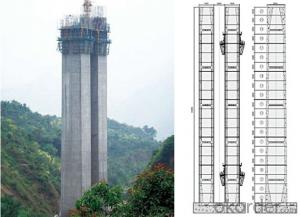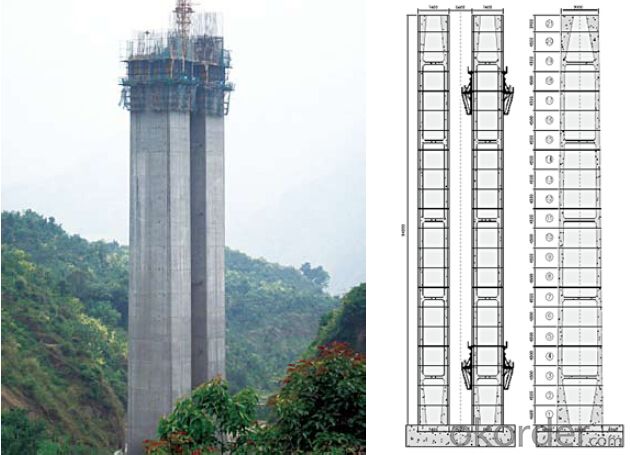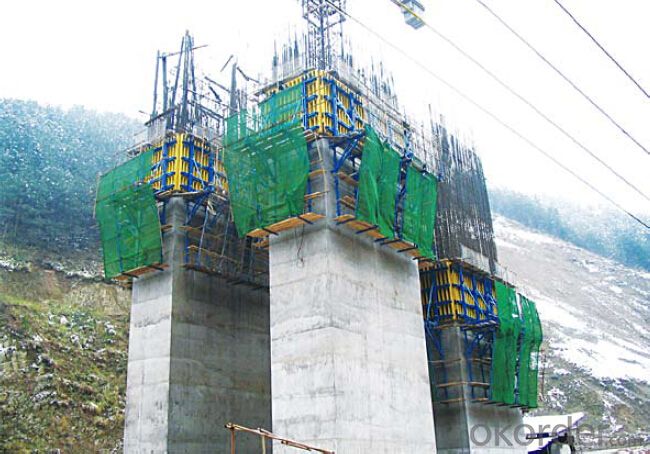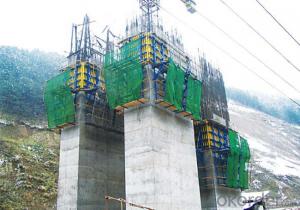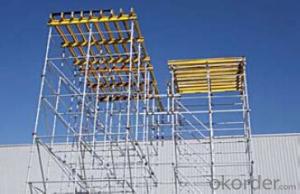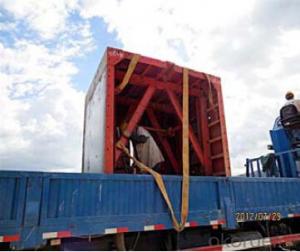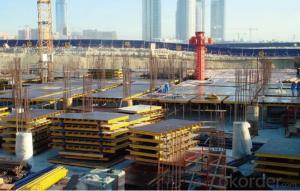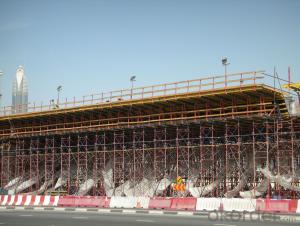Climbing Bracket CB210 for formwork and scaffolding system
- Loading Port:
- Tianjin
- Payment Terms:
- TT OR LC
- Min Order Qty:
- 50 m²
- Supply Capability:
- 1000 m²/month
OKorder Service Pledge
OKorder Financial Service
You Might Also Like
Climbing Bracket CB240 & CB210
They are framework brackets for supporting large-area wall formwork.
Typical applications for the CB240&CB210 are pier and column/shear wall/core walll/ in the
building.
CB210 has smaller size than CB240, it will be cost effective in some condition.
Characteristics:
◆ High bearing capacity
The high loading capacity of the brackets allow very large scaffold units. This saves the number
anchor points required as well as reducing climbing times.
◆ Simple moving procedure by crane
Through the strong connection of formwork together with the climbing scaffold, both can be moved
as a single climbing unit by crane. Thus valuable time-savings can be achieved.
◆ Fast striking process without a crane
With the retrusive set, large formwork elements can also be retracted quickly and a minimum of
effort.
◆ Safe with work platform
The platforms have assembled firmly with bracket and will be climbing together, without scaffolding
but can work safely in spite of your high location.
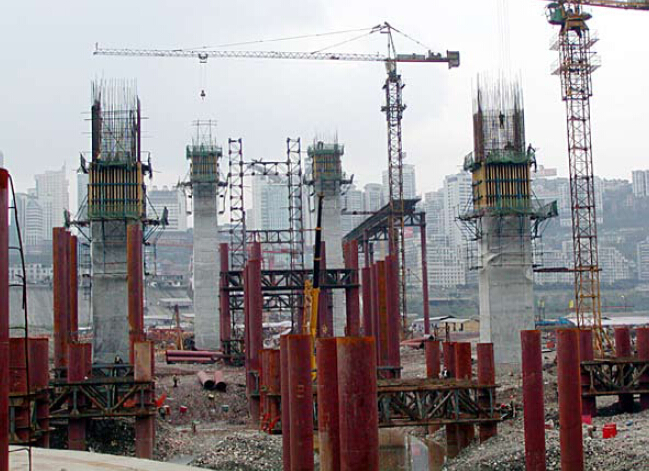
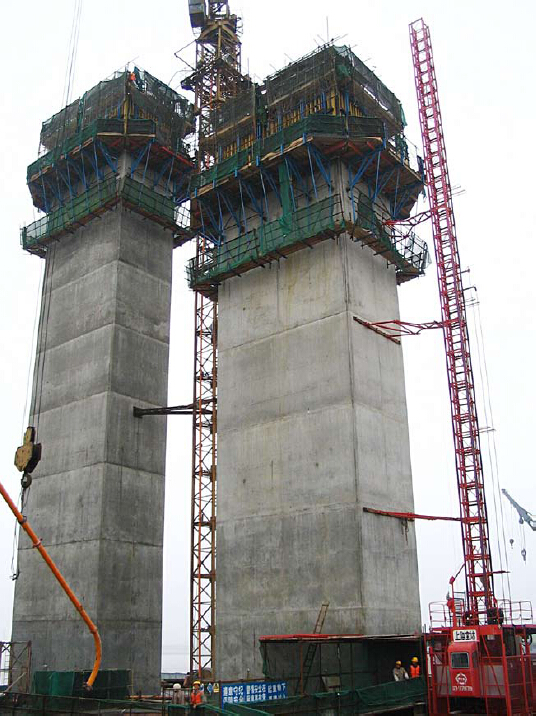
- Q: How does steel formwork handle concrete pump pressure?
- Steel formwork is well-suited to handle the pressure exerted by a concrete pump. Steel is a strong and durable material that can withstand high levels of pressure without deforming or failing. The formwork system is designed to distribute the force of the concrete pump evenly throughout the structure, preventing any localized areas of stress concentration. Additionally, steel formwork is rigid and stable, ensuring that it maintains its shape and integrity during the pumping process. This allows for the smooth and efficient flow of concrete, without any risk of the formwork collapsing or buckling under the pressure. Overall, steel formwork is specifically engineered to handle the concrete pump pressure, making it a reliable and safe choice for construction projects.
- Q: How does steel formwork handle concrete shrinkage and expansion?
- Steel formwork handles concrete shrinkage and expansion by providing a rigid framework that supports and contains the concrete during the curing process. The steel formwork is designed to withstand the pressure exerted by the concrete, preventing any deformation or cracking that may occur due to shrinkage or expansion. Its strength and durability ensure that the formwork remains intact and stable, effectively managing the dimensional changes of the concrete.
- Q: What are the typical deflection limits for steel formwork systems?
- The typical deflection limits for steel formwork systems can vary depending on several factors, including the specific design and application requirements of the project. However, there are some general guidelines that are commonly followed. In most cases, the deflection limits for steel formwork systems are typically determined based on the span length and the load applied to the formwork. As a general rule, the deflection limits for steel formwork systems are often limited to L/360 or L/240, where L represents the span length of the formwork. For example, if the span length of the formwork is 10 feet, the deflection limit would be L/360, which equals approximately 0.028 feet or 0.34 inches. This means that the maximum allowable deflection for this formwork system would be 0.34 inches, ensuring that the formwork remains stable and does not significantly deform under the applied load. It is important to note that these deflection limits may be adjusted based on the specific project requirements or industry standards. For instance, in certain high-rise construction projects, stricter deflection limits may be imposed to ensure the structural integrity and overall safety of the formwork system. Ultimately, the deflection limits for steel formwork systems must be carefully considered and evaluated during the design and construction process to ensure the formwork can effectively support the applied loads and maintain its stability throughout the construction process. Consulting with a structural engineer or referring to relevant industry standards can provide more specific and accurate deflection limits for a given steel formwork system.
- Q: What are the different types of formwork connectors used in steel formwork?
- There are several different types of formwork connectors used in steel formwork, including wedge clamps, wedge bolts, pin and wedge systems, and snap ties. These connectors are essential for securely joining formwork panels together and ensuring the stability and strength of the formwork structure.
- Q: Can steel formwork be used in cultural or entertainment facility construction projects?
- Yes, steel formwork can be used in cultural or entertainment facility construction projects. Steel formwork offers several advantages such as durability, strength, and the ability to withstand heavy loads. These qualities make it suitable for constructing large and complex structures found in cultural and entertainment facilities, such as theaters, concert halls, museums, and stadiums. Additionally, steel formwork can be easily customized to meet the specific design requirements of these facilities, providing flexibility and efficiency in the construction process. Moreover, steel formwork is reusable, which can result in cost savings and reduced environmental impact. Overall, steel formwork is a viable option for cultural or entertainment facility construction projects due to its strength, durability, flexibility, and cost-effectiveness.
- Q: How does steel formwork contribute to faster construction?
- There are several ways in which steel formwork speeds up construction. Firstly, steel formwork is exceptionally durable and can endure multiple uses. This means it can be reused on various construction projects, reducing the need to constantly manufacture new formwork. This not only saves time but also cuts costs associated with buying new materials for each project. Moreover, steel formwork is quick and simple to assemble and disassemble. The modular nature of steel formwork allows for efficient installation and removal, enabling construction teams to complete projects at a faster pace. This is particularly advantageous for projects with tight schedules or where speed is crucial. Furthermore, steel formwork provides a smooth and consistent surface finish, eliminating the need for additional plastering or finishing work. This saves time and effort during the construction process, as there is no need to wait for plaster or other finishing materials to dry before moving on to the next stage. Additionally, steel formwork offers greater design flexibility. Steel can be easily fabricated into various shapes and sizes, allowing for the construction of complex structures. This versatility eliminates the need for expensive and time-consuming custom formwork solutions, as steel formwork can be adapted to meet the specific requirements of each project. Lastly, steel formwork is renowned for its excellent strength and stability. It can withstand heavy loads and adverse weather conditions, ensuring the safety and stability of the construction site. This reduces the risk of delays due to structural issues or the need for additional reinforcements, allowing the construction process to progress smoothly and efficiently. Overall, the use of steel formwork in construction projects speeds up construction by providing durability, easy assembly and disassembly, a smooth surface finish, design flexibility, and enhanced strength and stability. These factors combined help to streamline the construction process and reduce the overall project timeline.
- Q: What are the considerations when designing steel formwork for architectural canopies?
- When designing steel formwork for architectural canopies, several considerations need to be taken into account. Firstly, the structural integrity and load-bearing capacity of the steel formwork should be carefully calculated to ensure it can withstand the expected loads and forces. Additionally, the formwork should be designed to be easily assembled and disassembled, allowing for efficient installation and removal. The formwork should also be designed to accommodate any necessary openings or cutouts for lighting fixtures or other architectural elements. Finally, aesthetic considerations such as the finish and appearance of the steel formwork should be taken into consideration to ensure it complements the overall design of the canopy.
- Q: Are there any specific considerations for using steel formwork in areas with limited power supply?
- Yes, there are several specific considerations for using steel formwork in areas with limited power supply. Firstly, steel formwork typically requires power tools for assembly and disassembly. In areas with limited power supply, it may be challenging to operate these tools efficiently. Alternative methods such as manual tools or hand-held equipment may need to be used, which can significantly increase the time and labor required for formwork installation and removal. Secondly, steel formwork often requires welding or cutting, which typically relies on electricity. In areas with limited power supply, finding suitable alternatives for these processes becomes crucial. For example, gas-powered welding machines or oxy-fuel cutting equipment may need to be considered. However, these alternatives come with their own set of challenges, such as obtaining and storing fuel safely. Additionally, areas with limited power supply may also face issues related to lighting. Adequate lighting is essential during formwork installation and concrete pouring to ensure accuracy and safety. Using alternative lighting sources such as battery-powered or solar-powered lights may be necessary. Furthermore, steel formwork often requires proper cleaning and maintenance to ensure its longevity and reusability. Cleaning equipment, such as pressure washers or power scrubbers, may not be readily available in areas with limited power supply. In such cases, manual cleaning methods or low-power alternatives may need to be employed. Lastly, power supply limitations may also affect the overall productivity and efficiency of the construction project. With limited power, it may be necessary to carefully plan and schedule the use of power-intensive equipment, such as concrete mixers or pumps, to minimize disruptions and maximize the available power resources. In conclusion, using steel formwork in areas with limited power supply requires careful consideration and planning. Alternative methods, tools, and equipment may need to be employed to overcome the challenges posed by the lack of power availability. It is essential to assess the specific requirements of the project and consult with experts to ensure the successful implementation of steel formwork in such areas.
- Q: Can steel formwork be used for precast concrete walls?
- Precast concrete walls can indeed utilize steel formwork. Steel formwork is widely employed in the construction industry due to its robustness, longevity, and reusability. It furnishes a stable and sturdy structure for the casting and molding of concrete during the manufacturing process of precast concrete walls. The utilization of steel formwork is appropriate for precast concrete walls because it can endure the pressure exerted by the wet concrete without bending or distorting. It guarantees that the concrete is poured and solidified in the desired shape and dimensions. Additionally, steel formwork can be effortlessly assembled and disassembled, enabling efficient and cost-effective production of precast concrete walls. An added benefit of employing steel formwork for precast concrete walls is its ability to generate smooth finishes. The steel panels or molds can be fashioned to create diverse textures and patterns on the final wall surface. This adaptability allows for increased design options and aesthetic appeal in the end product. Furthermore, steel formwork can be reused numerous times, making it an environmentally friendly and economical choice for precast concrete wall production. The durability of steel ensures that it can withstand the repetitive strains of the manufacturing process without significant deterioration. To summarize, due to its strength, durability, reusability, and capacity to produce smooth finishes, steel formwork is a suitable material for precast concrete walls. It establishes a solid framework for the molding and casting of concrete, permitting efficient and cost-effective production of precast concrete walls.
- Q: What are the considerations when designing steel formwork for underground structures?
- When designing steel formwork for underground structures, several considerations need to be taken into account. Firstly, the formwork should be sturdy and durable enough to withstand the pressure exerted by the surrounding soil. Underground structures often face significant lateral and vertical loads, so the formwork needs to be able to resist these forces without deforming or collapsing. Steel is an ideal material for this purpose due to its high strength and rigidity. Secondly, the formwork should be designed in a way that allows for easy installation and removal. Underground construction can be challenging due to limited access and confined working spaces. Therefore, the formwork system should be modular and easily adjustable to fit different shapes and sizes of underground structures. This would enable efficient construction and minimize the time and effort required for formwork installation and removal. Additionally, the formwork design should consider the ease of concrete pouring and subsequent curing. Proper consideration should be given to the placement of tie rods, formwork joints, and other structural elements to ensure that the concrete can flow smoothly and evenly throughout the structure. The formwork system should also incorporate adequate provisions for ventilation and drainage to prevent the accumulation of water or air pockets, which could compromise the structural integrity of the underground construction. Moreover, safety is a paramount consideration when designing steel formwork for underground structures. The formwork system should have appropriate safety features, such as guardrails and access platforms, to provide a secure working environment for the construction workers. The design should also consider the use of lifting and handling equipment to minimize manual handling and reduce the risk of accidents or injuries during formwork installation and dismantling. Lastly, the formwork design should take into account the project's budget and schedule constraints. Steel formwork can be more expensive than other types of formwork, so cost-effective design solutions should be explored without compromising safety and performance. Additionally, the formwork system should be designed for easy reusability, allowing for multiple applications and reducing the overall project costs. In conclusion, designing steel formwork for underground structures requires careful consideration of factors such as strength, durability, ease of installation, concrete pouring, safety, and cost-effectiveness. By addressing these considerations, designers can ensure the successful construction of underground structures that meet the project's requirements and withstand the challenges of underground environments.
Send your message to us
Climbing Bracket CB210 for formwork and scaffolding system
- Loading Port:
- Tianjin
- Payment Terms:
- TT OR LC
- Min Order Qty:
- 50 m²
- Supply Capability:
- 1000 m²/month
OKorder Service Pledge
OKorder Financial Service
Similar products
Hot products
Hot Searches
